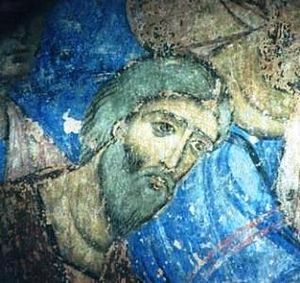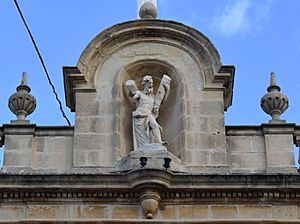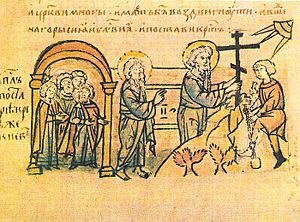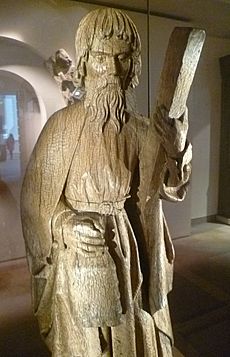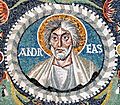Andrew the Apostle facts for kids
Quick facts for kids SaintAndrew the Apostle |
|
|---|---|
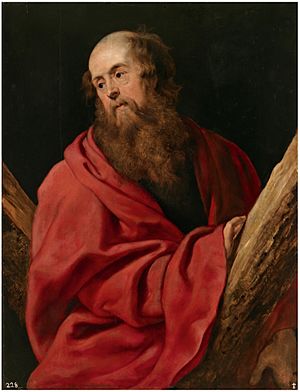
Saint Andrew (c. 1611) by Peter Paul Rubens
|
|
| Apostle and martyr | |
| Born | c. AD 5 Bethsaida, Galilee, Roman Empire |
| Died | AD 60/70 Patras, Achaea, Roman Empire |
| Venerated in | All Christian denominations which venerate saints |
| Major shrine | St Andrew's Cathedral, Patras, Greece; St Mary's Cathedral, Edinburgh, Scotland; the Church of St Andrew and St Albert, Warsaw, Poland; Duomo Cathedral in Amalfi and Sarzana Cathedral in Sarzana, Italy. |
| Feast | 30 November |
| Attributes | long white hair and beard, holding the Gospel Book or scroll, leaning on a saltire, fishing net |
| Patronage | Scotland, Barbados, Georgia, Ukraine, Russia, Greece, Cyprus, Romania, Patras, Burgundy, San Andrés (Tenerife), Diocese of Parañaque, Candaba, Pampanga, Masinloc, Telhado, Sarzana, Pienza, Amalfi, Luqa (Malta), Manila and Prussia; Diocese of Victoria; fishermen, fishmongers and rope-makers, textile workers, singers, miners, pregnant women, butchers, farm workers, protection against sore throats, protection against convulsions, protection against fever, protection against whooping cough, Russian Navy, Tables of Authority |
Andrew the Apostle, also known as Saint Andrew, was one of the twelve apostles of Jesus. He is mentioned in the New Testament of the Bible. Andrew was the brother of Simon Peter and the son of Jonah. In the Orthodox tradition, he is called "the First-Called" (Prōtoklētos).
According to Orthodox beliefs, the leader who follows Andrew is the Patriarch of Constantinople.
Contents
Life of Saint Andrew
The name "Andrew" means manly or brave. It was a common Greek name among Jewish people around 200 or 300 BC. There is no record of him having a Hebrew or Aramaic name.
Andrew the Apostle was born in Bethsaida, a town in Galilee, between 5 and 10 AD. The New Testament says that Andrew and his brother, Simon Peter, were both sons of Jonah. Andrew's Greek name shows that his family was open to Greek culture. This was common in Galilee, where Greek language and culture were present.
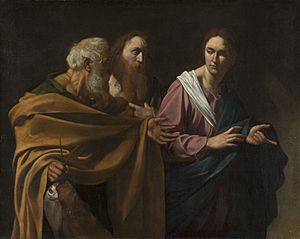
Both Andrew and Peter worked as fishermen. This is why Jesus called them to be his disciples by saying he would make them "fishers of men". The Bible says that at the start of Jesus' public life, they lived in the same house in Capernaum.
In the Gospel of Matthew and the Gospel of Mark, Jesus called Simon Peter and Andrew together. He saw them fishing by the Sea of Galilee and invited them to follow him.
The Gospel of John tells a slightly different story. It says Andrew was a follower of John the Baptist. John the Baptist's words led Andrew and another disciple to follow Jesus. Andrew quickly realized Jesus was the Messiah. He then hurried to introduce Jesus to his brother, Simon Peter. Because he was one of the first to be called, the Byzantine Church honors him with the name Protokletos, meaning "the first called". From then on, both brothers were disciples of Christ. Later, they were called to follow Jesus more closely, and they left everything to do so.
Andrew is mentioned as being present at some important events with Jesus. He told Jesus about the boy with the loaves and fishes. When some Greeks wanted to see Jesus, they went to Philip, who then asked Andrew for help. Andrew was also at the Last Supper. He was one of the four disciples who asked Jesus about the signs of his return.
Andrew's Journeys and Death
Historians like Eusebius say that Andrew preached in Scythia, an ancient region. The Chronicle of Nestor adds that he preached along the Black Sea and the Dnieper River all the way to Kiev. From there, he traveled to Novgorod. Because of this, he became a patron saint of Ukraine, Romania, and Russia.
According to tradition, Andrew was killed for his faith in the city of Patras in Achaea around AD 60. Early writings say Andrew was tied, not nailed, to a Latin cross, similar to the one Jesus was crucified on. However, a tradition later grew that Andrew was crucified on an X-shaped cross, called a crux decussata or "Saint Andrew's Cross". This was supposedly at his own request, as he felt he was not worthy to die on the same type of cross as Jesus. Pictures showing Andrew on an X-shaped cross became common in the later Middle Ages.
The Acts of Andrew
The apocryphal Acts of Andrew is a collection of stories about Andrew. It was written around the mid-2nd century. It describes Andrew's supposed travels, the miracles he performed, and how he died. Some early church leaders, like Eusebius, thought this work was not accurate or true.
Saint Andrew's Relics
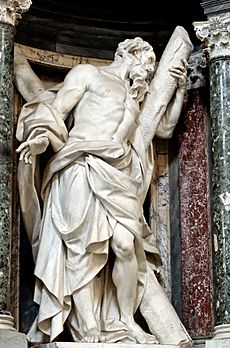
Parts of Saint Andrew's body, called relics, are kept in several places. These include the Basilica of Saint Andrew in Patras, Greece; the Amalfi Cathedral in Amalfi, Italy; and St Mary's Roman Catholic Cathedral in Edinburgh, Scotland.
Andrew's remains were first kept in Patras. Around 357 AD, most of his relics were moved to Constantinople by the Roman emperor Constantius II.
According to one story, a monk named Regulus (Rule) was told in a dream to hide some of the bones. Later, an angel told him to take the hidden relics "to the ends of the earth" for safety. Regulus sailed west and was shipwrecked on the coast of Fife, Scotland. He then built a shrine there. However, it's more likely that the relics were brought to Britain around 597 AD and then to Fife in 732 AD by Bishop Acca of Hexham.
The skull of Saint Andrew, which was in Constantinople, was returned to Patras by Emperor Basil I between 867 and 886 AD.
In 1208, after Constantinople was attacked, some relics of Saint Andrew were taken to Amalfi, Italy. A cathedral was built there to house them.
In 1461, Thomas Palaeologus, a Byzantine prince, brought what was believed to be Saint Andrew's skull to Italy. He gave it to Pope Pius II, who placed it in St. Peter's Basilica in the Vatican.
In September 1964, Pope Paul VI returned the skull of Saint Andrew from the Vatican to Patras as a sign of friendship with the Greek Orthodox Church. The cross of Saint Andrew, which had been taken during the Crusades, was also returned to Patras in 1980. All these relics are now kept in the Church of St. Andrew at Patras. They are honored in a special ceremony every 30 November, which is his feast day.
Traditions and Legends Around the World
Georgia
The Georgian Orthodox Church believes Andrew was the first person to preach Christianity in Georgia. This tradition comes from old Byzantine writings. These writings say Andrew preached to people around the Black Sea. This story helped the Georgian church claim it had an apostolic origin. The Georgian Orthodox Church celebrates Saint Andrew on May 12 and December 13. May 12, marking Andrew's arrival in Georgia, is a public holiday.
Cyprus
Cypriot tradition says that Andrew's ship went off course and landed on the island. When he came ashore, Andrew struck the rocks with his staff. A spring of healing water appeared. The ship's captain, who was blind in one eye, used the water and could see again. This spot became a place for pilgrims. A fortified monastery, the Apostolos Andreas Monastery, was built there.
The Apostolos Andreas Monastery is a very important place for the Cypriot Orthodox Church. It is sometimes called 'the Lourdes of Cyprus'. Both Greek Cypriots and Turkish Cypriots see it as a holy place. Many people visit it to pray.
Malta
Saint Andrew (Sant' Andrija) is the patron saint of Luqa in Malta. His feast day is celebrated on the first Sunday of July, and the church feast is on November 30. A small chapel dedicated to Andrew in Luqa dates back to 1497. Many fishermen used to live in Luqa, which might be why Andrew was chosen as their patron saint.
Romania
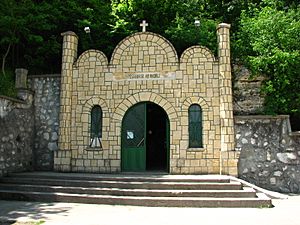
Saint Andrew is the patron saint of Romania. The Romanian Orthodox Church believes Andrew preached the Gospel in the area of Dobruja (ancient Scythia Minor). He is said to have converted the local people to Christianity. This tradition became widely accepted in the 20th century.
Some old sources, like those from Hippolyte of Antioch and Eusebius of Caesarea, mention Andrew preaching in Scythia. This could refer to Scythia Minor, which is now part of Romania.
East Slavs
Tradition says that Andrew preached along the southern borders of modern-day Ukraine, near the Black Sea. Legend says he traveled up the Dnieper River to where Kyiv now stands. There, he put up a cross and predicted that a great Christian city would be built there. Because of this, Andrew is considered the patron saint of Ukraine and Russia. Russia uses the Saint Andrew's Cross on its naval flag.
Scotland

Several legends say that Andrew's relics were brought from Constantinople to the place where the Scottish town of St Andrews is today. The oldest stories say that a monk named Regulus brought the relics to the Pictish king Óengus mac Fergusa (729–761).
According to a 16th-century legend, in 832 AD, King Óengus II led an army of Picts and Scots into battle. He was greatly outnumbered. The night before the battle, Óengus prayed and promised that if he won, he would make Andrew the patron saint of Scotland. On the morning of the battle, white clouds forming an X shape appeared in the sky. Óengus and his army felt encouraged. They won the battle, even though they had fewer soldiers. Óengus believed the X-shaped clouds represented the cross Andrew was crucified on. He kept his promise and made Andrew the patron saint of Scotland. The white saltire on a blue background, which is the flag of Scotland, is said to come from this legend.
Andrew's connection with Scotland may have become stronger after the Synod of Whitby. This is when the Celtic Church felt that Saint Columba was "outranked" by Saint Peter. So, Peter's brother, Andrew, would be a higher-ranking patron. The 1320 Declaration of Arbroath states that Scotland was converted to Christianity by Andrew, "the first to be an Apostle." Many churches in Scotland are named after Andrew.
In northern England and Scotland, there's a local superstition. People use the cross of Saint Andrew as a symbol on fireplaces. This is meant to stop witches from flying down the chimney and entering the house.
Spain
Saint Andrew was the patron saint of the Dukes of Burgundy. An X-shaped cross, called the Cross of Bourgogne, was used as the flag of the Duchy of Burgundy. When Spain took over the Duchy, this cross was used by the Spanish Crown. It was later a Spanish naval flag and an army battle flag until 1843. Today, it is still part of some Spanish military symbols and the Coat of Arms of the king of Spain.
In Spain, Andrew is the patron of several towns and cities.
Saint Andrew's Legacy
Andrew is the patron saint of many countries and cities. These include Barbados, Romania, Russia, Scotland, Ukraine, and Greece. He is also considered the founder and first bishop of the Church of Byzantium. Because of this, he is the patron saint of the Ecumenical Patriarchate of Constantinople.
The flag of Scotland features Saint Andrew's saltire cross. This cross is also part of the Union Flag and flags of some former British colonies. The saltire is also the flag of Tenerife and the Russian Navy Ensign.
The feast of Andrew is celebrated on November 30 in both Eastern and Western Christian churches. It is a public holiday in Scotland. There are week-long celebrations in the town of St Andrews and other Scottish cities.
In Islam
The Qur’an does not name the disciples of Jesus. However, Muslim scholars generally agree with the New Testament list and say that Andrew was one of the disciples.
In Art
In art, Saint Andrew is usually shown with a long, forked beard, a cross, and a book. Masaccio's 1426 painting "Saint Andrew" is a famous artwork. It is now in the Getty Center in Los Angeles, California. Andrew also appears in Carlo Crivelli's San Domenico Altarpiece from 1476. This painting is in the National Gallery in London. Hans Holbein the Younger made a drawing of the saint around 1519. It was a design for a stained glass window. This drawing is kept in the Kunstmuseum Basel.
Images for kids
-
Andrew the Apostle, detail of the mosaic in the Basilica of San Vitale, Ravenna, 6th century
See Also
 In Spanish: Andrés el Apóstol para niños
In Spanish: Andrés el Apóstol para niños
- Order of Saint Andrew
- Patron saints of places
- Saltire – the X-shaped cross in heraldry and vexillology
- St. Andrew's Cross (disambiguation)
- Saint Andrew's Day
- University of St Andrews — named after the Royal Burgh of St Andrews, which was named after the saint
- Saint Andrew the Apostle, patron saint archive




